oil level YAMAHA TMAX 2015 Owners Manual
[x] Cancel search | Manufacturer: YAMAHA, Model Year: 2015, Model line: TMAX, Model: YAMAHA TMAX 2015Pages: 112, PDF Size: 6.38 MB
Page 8 of 112

TABLE OF CONTENTSSAFETY INFORMATION................... 1-1
Further safe-riding points................. 1-5
DESCRIPTION ................................... 2-1
Left view .......................................... 2-1
Right view ........................................ 2-2
Controls and instrument s................. 2-3
SMART KEY SYSTEM ....................... 3-1
Smart key system ......... ................... 3-1
Operating range of the smart key
system ....................... ................... 3-2
Handling of the smart key and mechanical key ............................ 3-3
Smart key ........................................ 3-5
Replacing the smart key battery ...... 3-6
Vehicle power on and steering lock release .................................. 3-7
Powering off th e vehicle .................. 3-8
How to lock the steering .................. 3-9
Seat opening and closin g ................ 3-9
Parking mode ................................ 3-10
INSTRUMENT AND CONTROL
FUNCTIONS ....................................... 4-1
Indicator lights and warning lights ... 4-1
Speedometer ................................... 4-2
Tachometer ..................................... 4-3
Multi-function display ....................... 4-3
Handlebar switches ......................... 4-9
Front brake lever ........................... 4-11 Rear brake lever............................ 4-11
Rear brake lock lever .................... 4-12
ABS (for ABS models)...
................ 4-13
Fuel tank cap................................. 4-14
Fuel ............................................... 4-15
Catalytic converter ........................ 4-16
Adjusting the rider backrest........... 4-17
Helmet holder ................................ 4-17
Storage compartments .................. 4-18
Windshield..................................... 4-20
Rear view mirrors .......................... 4-21
Shock absorber assembly ............. 4-22
Sidestand ...................................... 4-22
Ignition circuit cut- off system ......... 4-23
Auxiliary DC connector.................. 4-25
FOR YOUR SAFETY –
PRE-OPERATION CHECKS ............. 5-1
OPERATION AND IMPORTANT
RIDING POINTS ................................. 6-1
Starting the engine .......................... 6-1
Starting off ....................................... 6-2
Acceleration and deceleration ......... 6-3
Braking ............................................ 6-3
Tips for reducing fuel consumption ................................ 6-4
Engine break-in ............................... 6-4
Parking ............................................ 6-5 PERIODIC MAINTENANCE AND
ADJUSTMENT
.................................... 7-1
Owner’s tool kit ................................ 7-2
Periodic maintenance chart for the emission control syst em ............... 7-3
General maintenance and lubrication chart ............................ 7-4
Removing and installing panels ....... 7-8
Checking the spark plugs .............. 7-10
Engine oil and oil filt er cartridge..... 7-11
Coolant .......................................... 7-14
Replacing the air filter element ...... 7-16
Adjusting the engine idling speed............ ............................ .. 7-16
Checking the throttle grip free play ............................................. 7-17
Valve clearance ............................. 7-17
Tires ............................................... 7-18
Cast wheels ................................... 7-20
Checking the front and rear brake
lever free play ............................. 7-20
Adjusting the rear brake lock cable ........................................... 7-21
Checking the rear brake lock ......... 7-22
Checking the front and rear brake pads............................................ 7-22
Checking the brake fluid level ........ 7-23
Changing the brake fluid ................ 7-24
Drive belt slack .............................. 7-24
Checking and lubricating the
cables
......................................... 7-25
2PW-9-E0_1.book 1 ページ 2015年2月19日 木曜日 午後3時30分
Page 15 of 112

2-1
123
4
5
6
7
8
9
10
11
12
DESCRIPTION
EAU10411
Left view
3
5
9 8
7
6
10
1
4
2
1. Battery (page 7-28)
2. Helmet holder (page 4-17)
3. Rear storage compartment (page 4-18)
4. Grab bar (page 6-2)
5. Engine oil filler cap (page 7-11)
6. Sidestand (page 4-22)
7. Engine oil drain bolt (page 7-11)
8. Engine oil level check window (page 7-11) 9. Oil filter cartridge (page 7-11)
10.Coolant level check window (page 7-14)
2PW-9-E0_1.book 1 ページ 2015年2月19日 木曜日 午後3時30分
Page 32 of 112
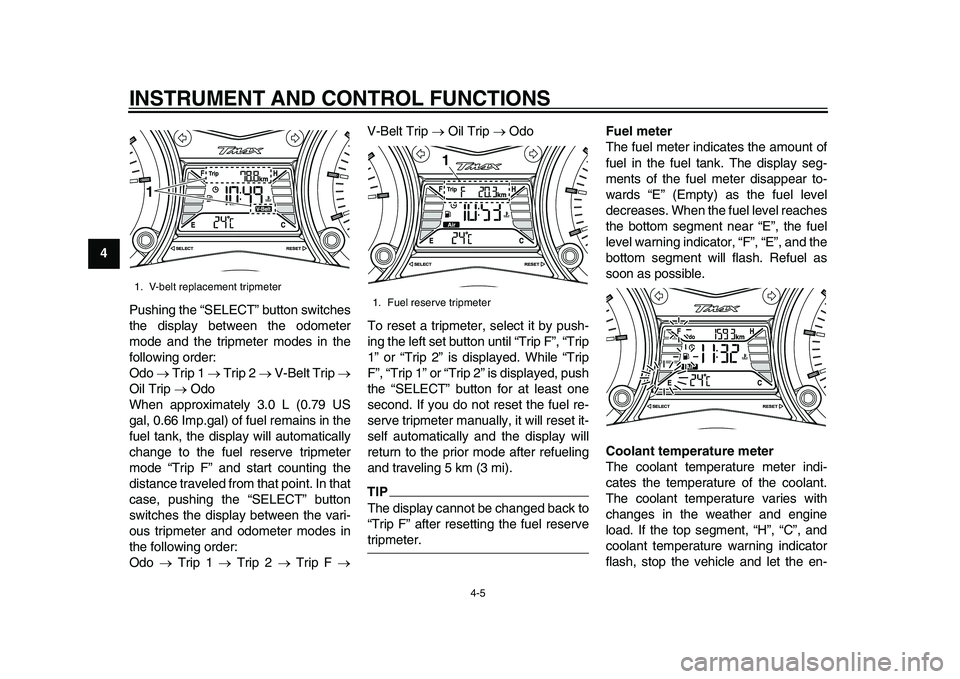
INSTRUMENT AND CONTROL FUNCTIONS
4-5
1
2
34
5
6
7
8
9
10
11
12 Pushing the “SELECT” button switches
the display between the odometer
mode and the tripmeter modes in the
following order:
Odo
Trip 1 Trip 2 V-Belt Trip
Oil Trip Odo
When approximately 3.0 L (0.79 US
gal, 0.66 Imp.gal) of fuel remains in the
fuel tank, the display will automatically
change to the fuel reserve tripmeter
mode “Trip F” and start counting the
distance traveled from that point. In that
case, pushing the “SELECT” button
switches the display between the vari-
ous tripmeter and odometer modes in
the following order:
Odo Trip 1 Trip 2 Trip F V-Belt Trip
Oil Trip Odo
To reset a tripmeter, select it by push-
ing the left set button until “Trip F”, “Trip
1” or “Trip 2” is displayed. While “Trip
F”, “Trip 1” or “Trip 2” is displayed, push
the “SELECT” button for at least one
second. If you do not reset the fuel re-
serve tripmeter manually, it will reset it-
self automatically and the display will
return to the prior mode after refueling
and traveling 5 km (3 mi).
TIPThe display cannot be changed back to
“Trip F” after resetting the fuel reservetripmeter. Fuel meter
The fuel meter indicates the amount of
fuel in the fuel tank. The display seg-
ments of the fuel meter disappear to-
wards “E” (Empty) as the fuel level
decreases. When the fuel level reaches
the bottom segment near “E”, the fuel
level warning indicator, “F”, “E”, and the
bottom segment will flash. Refuel as
soon as possible.
Coolant temperature meter
The coolant temperature meter indi-
cates the temperature of the coolant.
The coolant temperature varies with
changes in the weather and engine
load. If the top segment, “H”, “C”, and
coolant temperature warning indicator
flash, stop the vehicle and let the en-
1. V-belt replacement tripmeter1
1. Fuel reserve tripmeter
1
2PW-9-E0_1.book 5 ページ 2015年2月19日 木曜日 午後3時30分
Page 53 of 112
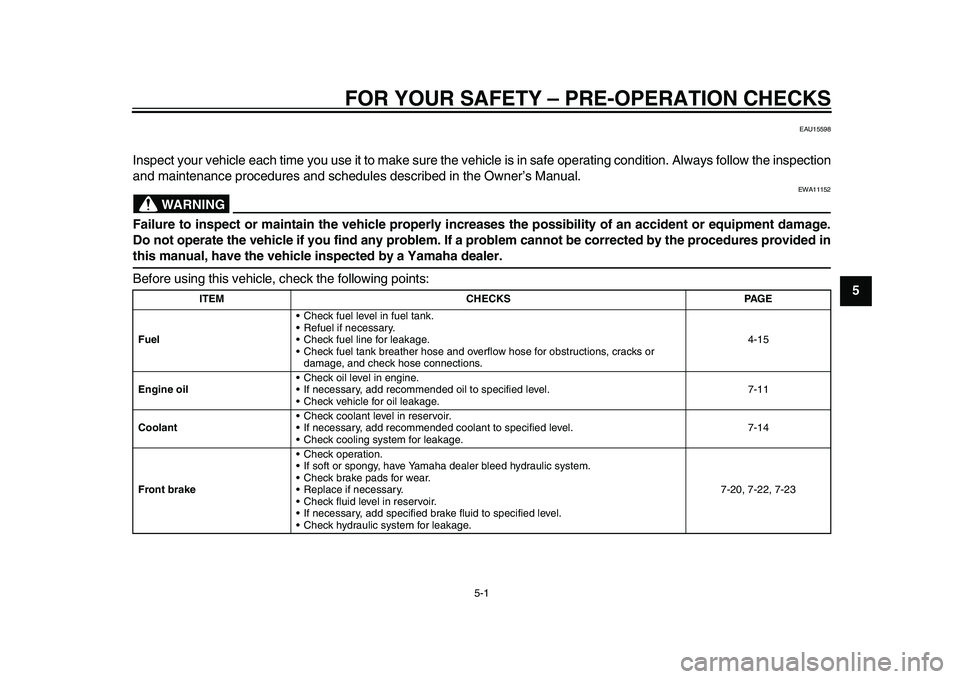
5-1
1
2
3
456
7
8
9
10
11
12
FOR YOUR SAFETY – PRE-OPERATION CHECKS
EAU15598
Inspect your vehicle each time you use it to make sure the vehicle is in safe operating condition. Always follow the inspection
and maintenance procedures and schedules described in the Owner’s Manual.
WARNING
EWA11152
Failure to inspect or maintain the vehicle properly increases the possibility of an accident or equipment damage.
Do not operate the vehicle if you find any problem. If a problem cannot be corrected by the procedures provided inthis manual, have the vehicle inspected by a Yamaha dealer.
Before using this vehicle, check the following points:
ITEM CHECKS PAGE
Fuel Check fuel level in fuel tank.
Refuel if necessary.
Check fuel line for leakage.
Check fuel tank breather hose and overflow hose for obstructions, cracks or
damage, and check hose connections. 4-15
Engine oil Check oil level in engine.
If necessary, add recommended oil to specified level.
Check vehicle for oil leakage. 7-11
Coolant Check coolant level in reservoir.
If necessary, add recommended coolant to specified level.
Check cooling system for leakage. 7-14
Front brake Check operation.
If soft or spongy, have Yamaha dealer bleed hydraulic system.
Check brake pads for wear.
Replace if necessary.
Check fluid level in reservoir.
If necessary, add specified brake fluid to specified level.
Check hydraulic system for leakage. 7-20, 7-22, 7-23
2PW-9-E0_1.book 1 ページ 2015年2月19日 木曜日 午後3時30分
Page 64 of 112
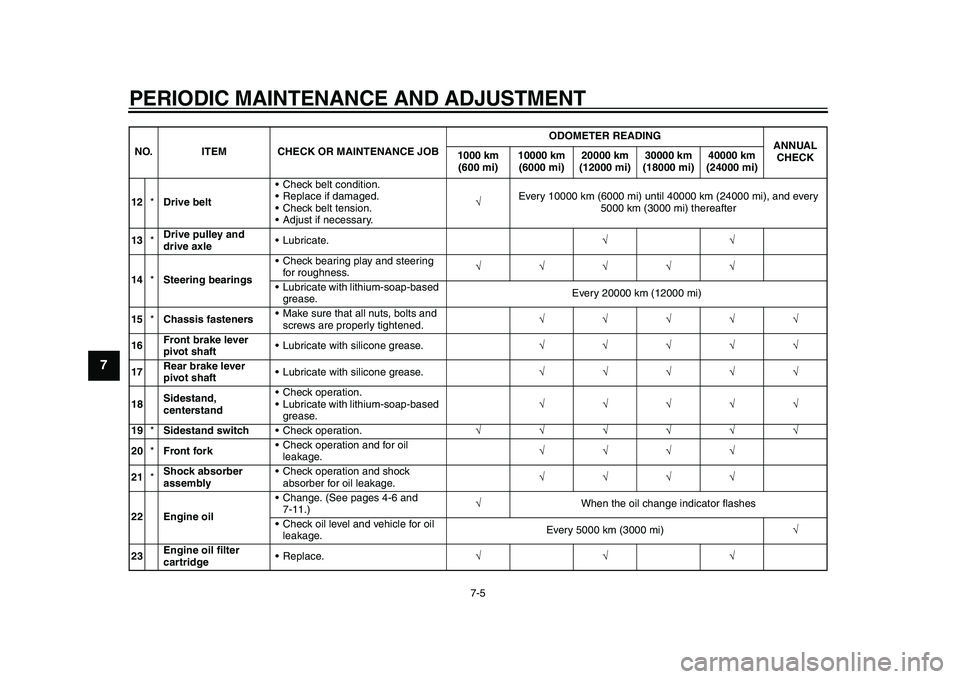
PERIODIC MAINTENANCE AND ADJUSTMENT
7-5
1
2
3
4
5
67
8
9
10
11
12
12 *Drive belt Check belt condition.
Replace if damaged.
Check belt tension.
Adjust if necessary.
Every 10000 km (6000 mi) until 40000 km (24000 mi), and every
5000 km (3000 mi) thereafter
13 *Drive pulley and
drive axle Lubricate.
14 *Steering bearings Check bearing play and steering
for roughness.
Lubricate with lithium-soap-based grease. Every 20000 km (12000 mi)
15 *Chassis fasteners Make sure that all nuts, bolts and
screws are properly tightened.
16 Front brake lever
pivot shaft Lubricate with silicone grease.
17 Rear brake lever
pivot shaft Lubricate with silicone grease.
18 Sidestand,
centerstand Check operation.
Lubricate with lithium-soap-based
grease.
19 *Sidestand switch Check operation.
20 *Front fork Check operation and for oil
leakage.
21 *Shock absorber
assembly Check operation and shock
absorber for oil leakage.
22 Engine oil Change. (See pages 4-6 and
7-11.)
When the oil change indicator flashes
Check oil level and vehicle for oil leakage. Every 5000 km (3000 mi)
23 Engine oil filter
cartridge
NO. ITEM CHECK OR MAINTENANCE JOB
ODOMETER READING
ANNUAL
CHECK
1000 km
(600 mi) 10000 km
(6000 mi) 20000 km
(12000 mi) 30000 km
(18000 mi) 40000 km
(24000 mi)2PW-9-E0_1.book 5 ページ 2015年2月19日 木曜日 午後3時30分
Page 66 of 112

PERIODIC MAINTENANCE AND ADJUSTMENT
7-7
1
2
3
4
5
67
8
9
10
11
12
EAU38263
TIP
Engine air filter and V-belt air filters
This model’s engine air filter is equipped with a disposable oil-coated paper element, which must not be cleaned with
compressed air to avoid damaging it.
The engine air filter element needs to be replaced and the V- belt air filter elements need to be serviced more frequent-
ly when riding in unusuall y wet or dusty areas.
Hydraulic brake service
After disassembling the brake master cylinders and calipers, always change the fluid. Regu larly check the brake fluid
levels and fill the reservoirs as required.
Every two years replace the internal components of the brake master cylinders and calipers, and change the brake fluid. Replace the brake hoses every four years and if cracked or damaged.
2PW-9-E0_1.book 7 ページ 2015年2月19日 木曜日 午後3時30分
Page 70 of 112
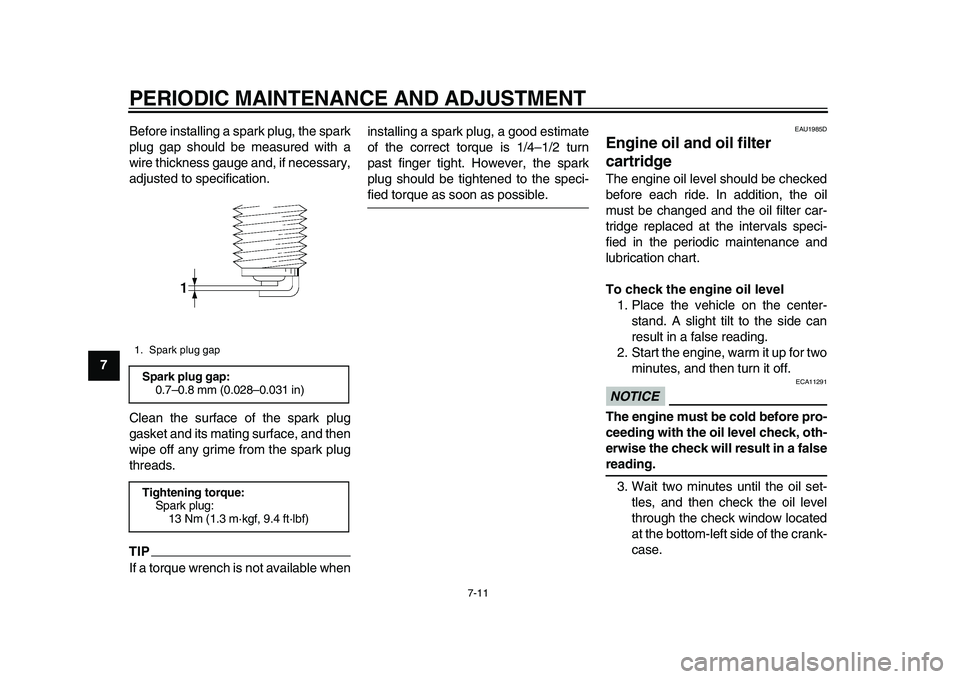
PERIODIC MAINTENANCE AND ADJUSTMENT
7-11
1
2
3
4
5
67
8
9
10
11
12 Before installing a spark plug, the spark
plug gap should be measured with a
wire thickness gauge and, if necessary,
adjusted to specification.
Clean the surface of the spark plug
gasket and its mating surface, and then
wipe off any grime from the spark plug
threads.
TIPIf a torque wrench is not available when installing a spark plug, a good estimate
of the correct torque is 1/4–1/2 turn
past finger tight. However, the spark
plug should be tightened to the speci-
fied torque as soon as possible.
EAU1985D
Engine oil and oil filter
cartridgeThe engine oil level should be checked
before each ride. In addition, the oil
must be changed and the oil filter car-
tridge replaced at the intervals speci-
fied in the periodic maintenance and
lubrication chart.
To check the engine oil level
1. Place the vehicle on the center- stand. A slight tilt to the side can
result in a false reading.
2. Start the engine, warm it up for two minutes, and then turn it off.NOTICE
ECA11291
The engine must be cold before pro-
ceeding with the oil level check, oth-
erwise the check will result in a falsereading.
3. Wait two minutes until the oil set- tles, and then check the oil level
through the check window located
at the bottom-left side of the crank-
case.
1. Spark plug gapSpark plug gap:0.7–0.8 mm (0.028–0.031 in)
Tightening torque: Spark plug:13 Nm (1.3 m·kgf, 9.4 ft·lbf)
2PW-9-E0_1.book 11 ページ 2015年2月19日 木曜日 午後3時30分
Page 71 of 112
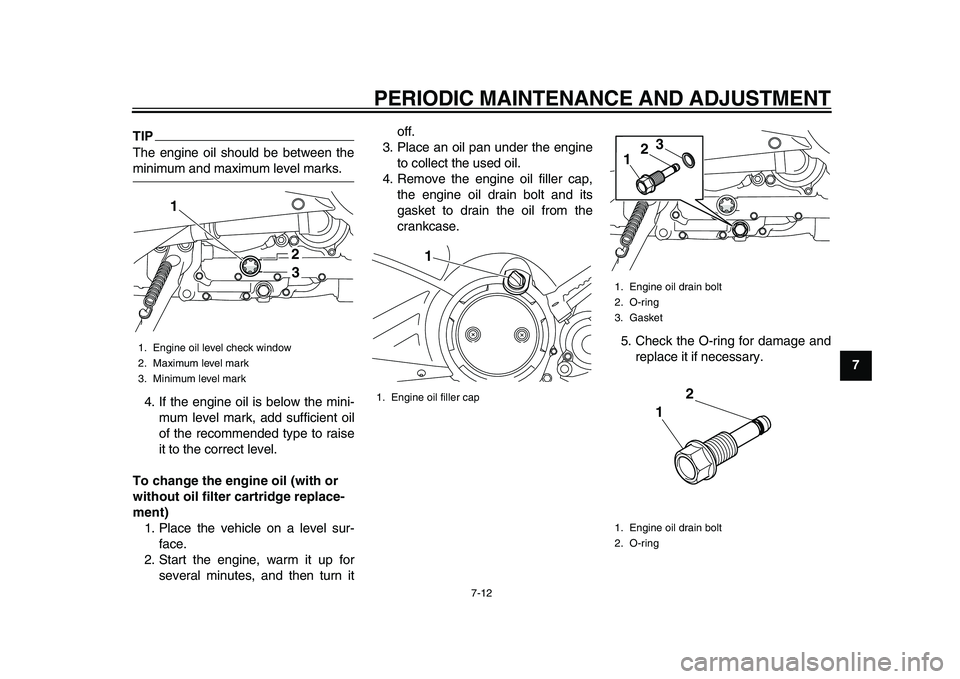
PERIODIC MAINTENANCE AND ADJUSTMENT
7-12
1
2
3
4
5
678
9
10
11
12
TIPThe engine oil should be between theminimum and maximum level marks.
4. If the engine oil is below the mini- mum level mark, add sufficient oil
of the recommended type to raise
it to the correct level.
To change the engine oil (with or
without oil filter cartridge replace-
ment) 1. Place the vehicle on a level sur- face.
2. Start the engine, warm it up for several minutes, and then turn it off.
3. Place an oil pan under the engine to collect the used oil.
4. Remove the engine oil filler cap, the engine oil drain bolt and its
gasket to drain the oil from the
crankcase.
5. Check the O-ring for damage andreplace it if necessary.1. Engine oil level check window
2. Maximum level mark
3. Minimum level mark
1
23
1. Engine oil filler cap
1
1. Engine oil drain bolt
2. O-ring
3. Gasket
1. Engine oil drain bolt
2. O-ring1 2
3
1 2
2PW-9-E0_1.book 12 ページ 2015年2月19日 木曜日 午後3時30分
Page 73 of 112
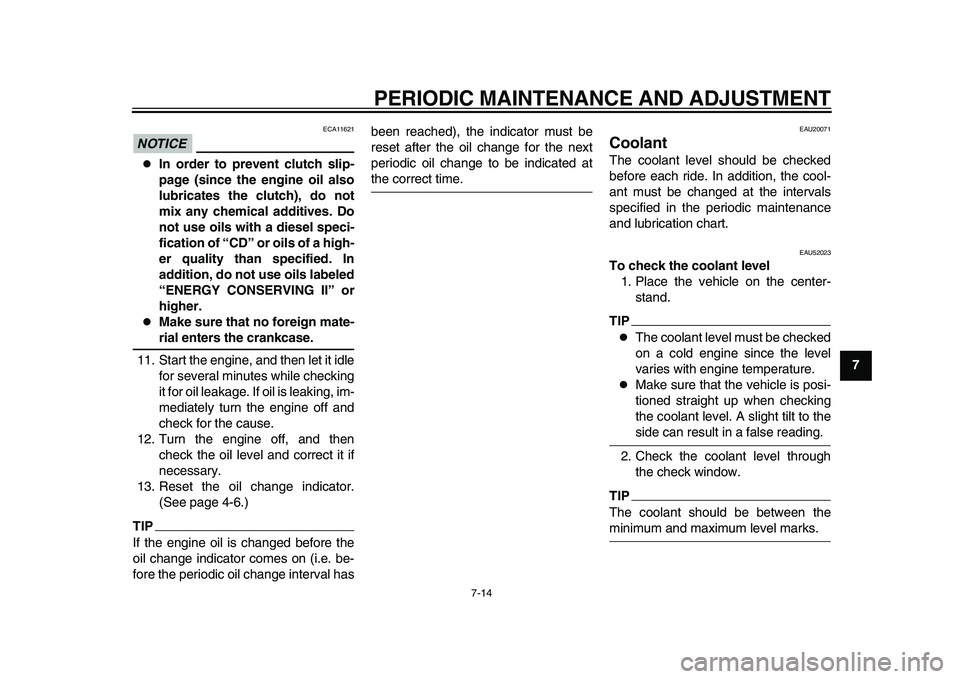
PERIODIC MAINTENANCE AND ADJUSTMENT
7-14
1
2
3
4
5
678
9
10
11
12
NOTICE
ECA11621
In order to prevent clutch slip-
page (since the engine oil also
lubricates the clutch), do not
mix any chemical additives. Do
not use oils with a diesel speci-
fication of “CD” or oils of a high-
er quality than specified. In
addition, do not use oils labeled
“ENERGY CONSERVING II” or
higher.
Make sure that no foreign mate-rial enters the crankcase.
11. Start the engine, and then let it idle for several minutes while checking
it for oil leakage. If oil is leaking, im-
mediately turn the engine off and
check for the cause.
12. Turn the engine off, and then check the oil level and correct it if
necessary.
13. Reset the oil change indicator. (See page 4-6.)
TIPIf the engine oil is changed before the
oil change indicator comes on (i.e. be-
fore the periodic oil change interval has been reached), the indicator must be
reset after the oil change for the next
periodic oil change to be indicated at
the correct time.
EAU20071
CoolantThe coolant level should be checked
before each ride. In addition, the cool-
ant must be changed at the intervals
specified in the periodic maintenance
and lubrication chart.
EAU52023
To check the coolant level
1. Place the vehicle on the center- stand.TIP
The coolant level must be checked
on a cold engine since the level
varies with engine temperature.
Make sure that the vehicle is posi-
tioned straight up when checking
the coolant level. A slight tilt to theside can result in a false reading.
2. Check the coolant level through the check window.
TIPThe coolant should be between theminimum and maximum level marks.
2PW-9-E0_1.book 14 ページ 2015年2月19日 木曜日 午後3時30分
Page 83 of 112
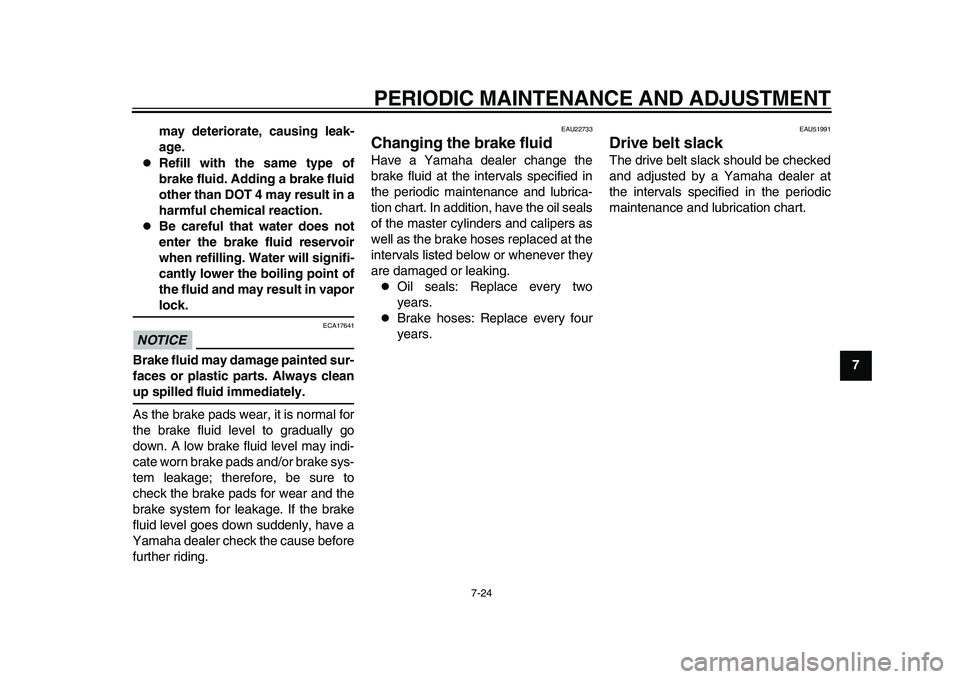
PERIODIC MAINTENANCE AND ADJUSTMENT
7-24
1
2
3
4
5
678
9
10
11
12
may deteriorate, causing leak-
age.
Refill with the same type of
brake fluid. Adding a brake fluid
other than DOT 4 may result in a
harmful chemical reaction.
Be careful that water does not
enter the brake fluid reservoir
when refilling. Water will signifi-
cantly lower the boiling point of
the fluid and may result in vaporlock.
NOTICE
ECA17641
Brake fluid may damage painted sur-
faces or plastic parts. Always cleanup spilled fluid immediately.
As the brake pads wear, it is normal for
the brake fluid level to gradually go
down. A low brake fluid level may indi-
cate worn brake pads and/or brake sys-
tem leakage; therefore, be sure to
check the brake pads for wear and the
brake system for leakage. If the brake
fluid level goes down suddenly, have a
Yamaha dealer check the cause before
further riding.
EAU22733
Changing the brake fluidHave a Yamaha dealer change the
brake fluid at the intervals specified in
the periodic maintenance and lubrica-
tion chart. In addition, have the oil seals
of the master cylinders and calipers as
well as the brake hoses replaced at the
intervals listed below or whenever they
are damaged or leaking.
Oil seals: Replace every two
years.
Brake hoses: Replace every four
years.
EAU51991
Drive belt slackThe drive belt slack should be checked
and adjusted by a Yamaha dealer at
the intervals specified in the periodic
maintenance and lubrication chart.
2PW-9-E0_1.book 24 ページ 2015年2月19日 木曜日 午後3時30分